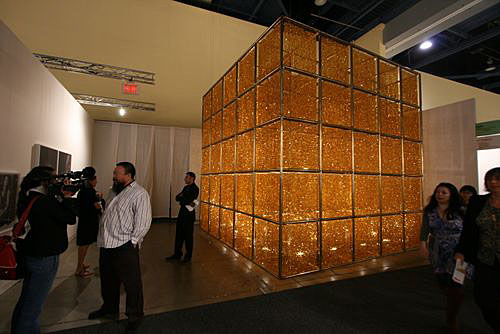This is a text in progress. It is an unfinished and incomplete version.
The Artist as Troublemaker
December 19, 2008 - March 28, 2009
Austrian Cultural Forum, 11 East 52nd Street, New York
produced by Andreas Stadler, curated by Peter Pakesch
The Artist as Troublemaker just opened at the Austrian Cultural Forum, curated by Peter Pakesch, manager and artistic director at the Museum Joanneum in Graz. The exhibition is concerned with the "trouble" certain artists provoke in their aesthetic practice, particularly with regard to the very spaces and structures in which they exhibit, their relation to the aims and conventions of these spaces, to their parameters of exhibition, and to their self image and self definition. It centers on museums as "the focal point and testing ground of the encounter" between artist and institution, and features the work of seven artists and/or artist collectives: Günter Brus, Clegg & Guttmann, Olafur Eliasson, Martin Kippenberger, Dorit Margreiter, Diana Thater, Sofie Thorsen.
This is, therefore, another rest stop on the well traveled international superhighway of institutional critique, although with an expected (and some might say appropriate) Austrian inclination in its selection of artists and in the nationalities of its curator and venue. This dialectic of local vs. global is a delicate balance that initiatives such as the ACF or the Swiss Institute need to satisfy in fulfilling a parochial mandate while also meeting the wider demands of speaking in the various ecumenical tongues of the art world. It is a continuing issue, not fully resolved. But ultimately, for an exhibition of this sort to fail or succeed would be according to the rigor of its definitions and the intentions of its thesis, not just for the artists and work chosen but for an overarching examination of artist/institutional interplay that we might hope to find ratified throughout. If there is not a single thread concerning the sort of institution that is being questioned nor the sort of inquiries that are being posed by the artists through their practice, we might still hope to find a multivalent approach that sheds light upon a series of institutionally founded critiques.
As Mr. Pakesch has mentioned in conversation, the museum as institution is relatively young, a scant two centuries within the long, long history of art. It has come under closer scrutiny in recent years as museums attempt to redefine themselves in a new millennium, and as artists, some working in new media or with new theoretical and semiotic concerns, push against the existing walls of the institution. This pending process of reinvention is particularly relevant to Pakesch as chief officer of a large museum that showcases not only contemporary art but also craft, the applied arts, period pieces and anthropological concerns - folk art, costume, implements, Baroque sculpture and painting - as well as natural history exhibits in geology, zoology and botany. Founded by Archduke Johann in 1811 (hence its name), the Joanneum hearkens back to that (now seemingly innocent) moment when the sum total of human knowledge and endeavor was deemed capable of being encompassed and studied under one roof. As the explosion of knowledge, communication systems and productivity in the last two centuries makes this conceit feel a bit quaint, it seems the museum has already needed to confront and reformulate the limits of its original institutional imperative.
In the current exhibition we find a multi-generational approach. As with many recent efforts in the reformulation of contemporary Austrian cultural history, its "year zero" is the formative and famous examples of Viennese Actionismus from the mid 1960s. Günter Brus serves as the spiritual and practical "grandfather" of The Artist as Troublemaker, and is represented by a series of b/w photographs documenting his "actions" involving blood, semen, urine, excrement, entrails and the mortification of the flesh, an intentional and primal investigation of the limits of performance, the endurance of the body and the ability of the state to tolerate and regulate the provocative content and execution of his performances. Brus has summarized his aesthetic practice with the triumvirate of Malerei, Selbstbemalung, Selbstverstümmelung (painting, self-painting, self-mutilation).











